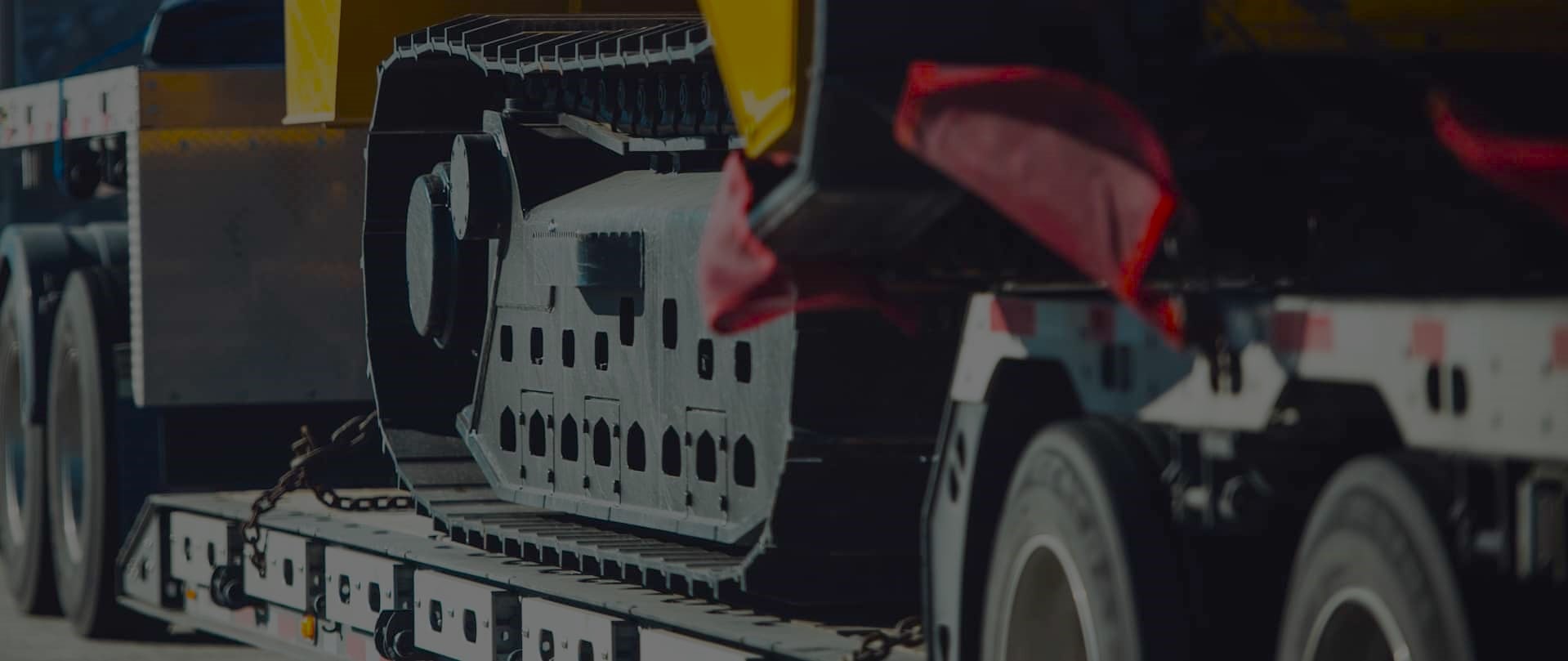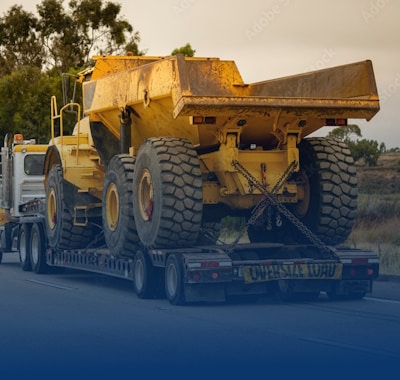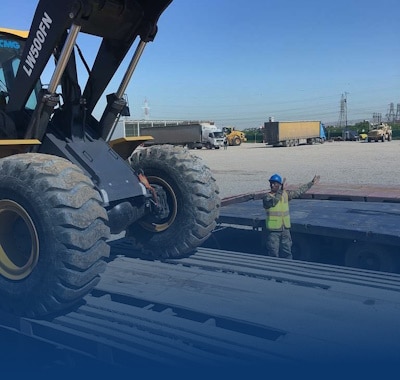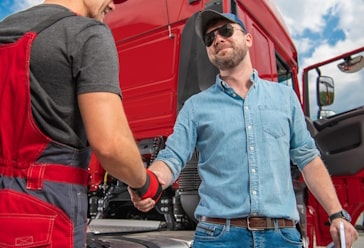Avoid the Risks of DIY Heavy Equipment Hauling
Freedom Heavy Haul can offer expedited Pickup and Delivery for any size shipment anywhere in the USA. Contact us today for No Hassle, No Pressure Pricing.
In today’s fast-paced construction world, many are tempted to haul heavy equipment themselves. But, this approach comes with big risks. It can lead to costly mistakes, safety hazards, and legal problems.
It’s important to put safety and professionalism first. Moving heavy equipment is not something to be taken lightly. We need to understand the dangers to protect our investments and keep operations running smoothly.
Understanding Heavy Equipment Transport
Heavy equipment transport is a complex task that needs careful planning. Moving big machinery is not easy and comes with many challenges. We look at the important parts for a successful move.
Choosing the right transport equipment is key. We must think about the weight, size, and type of machinery. Each piece has its own needs, affecting the vehicle and loading method choices.
Logistics are crucial in moving heavy equipment. This includes planning the route, timing, and getting the right permits. Missing any of these steps can lead to dangers. It’s important to plan for road conditions and obstacles to avoid delays and keep everyone safe.
Knowing all about transport shows the risks of trying to do it yourself. Without professional help, there’s a higher chance of problems. Employers and contractors need to understand that moving heavy equipment is more than just hauling it.
| Transport Aspect | Considerations | Risks of DIY Transport |
|---|---|---|
| Equipment Selection | Weight, size, and type | Incorrect choices may lead to accidents |
| Logistics | Route planning and permits | Legal issues and delays |
| Loading Methods | Safety equipment and secure techniques | Improper loading can cause damage |
Understanding these elements helps us see the dangers of heavy equipment transport. It also shows why we should use expert services for safe and efficient transport.
Common Types of Heavy Equipment Used in Construction
In construction, different heavy equipment play key roles. Knowing these machines is vital for managing and moving them. The main types are:
- Excavators: They are versatile, used for digging, grading, and demolition.
- Bull dozers: These machines move a lot of earth, essential for site prep.
- Cranes: Needed for lifting and moving heavy parts, crucial for tall buildings.
- Forklifts: Used for moving materials short distances, boosting job site efficiency.
Each heavy equipment type has special transport needs. It’s important to know about heavy equipment transport dangers. Improper handling can cause accidents and delays.
There are also rules and standards for moving these machines. Knowing these ensures safety and compliance. It’s all about keeping everyone safe during transport.
The Risks Associated with DIY Heavy Equipment Transport
Transporting heavy equipment on your own is risky. It can lead to big financial and legal problems. It’s important to know these risks before you try to move machinery yourself.
Financial Implications of Mistakes
DIY heavy equipment transport can cost a lot. Accidents or mistakes can damage the equipment, leading to expensive fixes or new purchases. Also, the vehicle used for hauling might get damaged, adding to the costs.
Accidents can lead to higher liability costs. This includes medical bills and damage to property. Knowing the financial risks is key. It helps avoid turning a cost-saving move into a big financial loss.
Legal Consequences of DIY Transport
It’s crucial to know the local laws for moving heavy equipment. Breaking these laws can lead to fines or legal trouble. Not knowing about permits needed for heavy machinery transport can also cause problems.
Understanding the legal side helps avoid these issues. It ensures the transport process follows local laws. Ignoring this can make the process much harder and lead to legal problems.
Heavy Equipment Transport Dangers
The world of heavy equipment transport is full of dangers. Heavy machinery can cause accidents, equipment failure, and harm the environment. These heavy equipment transport dangers can lead to property damage, serious injuries, or even death.
Accidents often happen because of bad loading or poor route planning. For example, a large excavator shifted during transport, causing the trailer to tip over. This led to road blockages and injuries to people nearby. Such incidents show how crucial it is to follow safety rules carefully.
Equipment failure is another big worry. Using untrained people to move heavy machinery can lead to neglecting maintenance. This increases the chance of mechanical failures during transport. Regular checks and following best practices can help avoid these heavy equipment transport dangers.
Environmental hazards are also a big concern. Weather, road conditions, and wildlife can pose unexpected challenges. For instance, moving machinery through rough terrain without proper preparation can cause severe accidents. To learn how to handle these risks, check out this resource.
Being aware and prepared is key to avoiding heavy equipment transport dangers. By taking thorough safety steps and knowing the risks, businesses can protect their investments and keep their workers safe on the road.
Do It Yourself Equipment Hauling Risks
Many people are drawn to hauling heavy equipment themselves. They see it as a way to save money. But, the risks are real and can be dangerous.
Trying to move heavy equipment without training can cause serious harm. It can also damage the equipment itself.
Physical Injury Risks
One big risk is getting hurt. Every year, many people get injured trying to move heavy machines. They might get strains, cuts, or even broken bones.
These injuries can lead to big medical bills and lost work time. It shows why it’s important to know the risks before trying to move equipment yourself.
Equipment Damage Risks
There’s also a risk of damaging the equipment. If it’s not loaded right or if you don’t know what you’re doing, it can get damaged. This can be very expensive.
Without the right skills, you might face:
- Damage to the equipment’s structure from bad securing.
- More wear and tear during transport because of poor protection.
- Liability if the equipment fails and causes an accident.
These problems can cost a lot of money. They can also make the DIY idea less appealing. It’s clear that moving heavy equipment should be left to the pros.
Common Hazards of Self-Transporting Heavy Equipment
Transporting heavy equipment yourself is full of challenges. Many accidents happen because of oversights. One big problem is loading it wrong, which can cause it to tip over.
Not securing the equipment properly is another issue. People often forget to use the right straps or chains. This can make the equipment move or fall, leading to serious accidents.
Ignoring road conditions is also risky. Drivers might not think about how weather or roads affect their load. Bad weather can make it hard to see and control the equipment.
It’s important to know these risks if you’re thinking about moving heavy equipment yourself. Even small mistakes can lead to big problems. This shows why it’s better to use professional help and safe transport methods.
Safety Risks of DIY Equipment Transport
Transporting heavy equipment can be tough, even when you do it yourself. It’s important to know the safety risks to avoid accidents. We’ll look at key loading and securing methods you should always use.
Proper Loading Techniques
Getting the load right is key to safe transport. Wrong loading can cause accidents. Here are some tips for safe loading:
- Measure the dimensions and weight of the machinery accurately.
- Balance the load by positioning heavier items toward the center of the transport vehicle.
- Use ramps that are properly rated for the weight of the equipment.
- Communicate clearly with any assistants to avoid misalignment during the loading process.
For more tips on avoiding transport mistakes, check out this guide on avoiding common shipping mistakes.
Securing Equipment for Transportation
Securing equipment is also crucial for safety. Unsecured equipment can move or fall, posing a risk. Here are some ways to secure it properly:
- Utilizing appropriate tie-downs rated for heavy loads.
- Ensuring that all straps and chains are tight without exceeding load limits.
- Placing chocks under wheels to prevent rolling during transport.
- Conducting a final inspection of all securing mechanisms before departure.
Following these steps can greatly reduce transport risks. Safety is not just for the equipment but for everyone around it too.
Why Hiring Professionals is Essential
Transporting heavy equipment is a big challenge. Hiring pros for this job has many benefits. They make the process safer and more efficient.
Choosing experts means we avoid the risks of doing it ourselves. This could save us from expensive mistakes or accidents.
Expertise and Experience
Professionals have a lot of knowledge and experience. They know how to handle different types of machinery safely. This reduces the risk of accidents during transport.
They are trained to handle any unexpected problems. This ensures your equipment gets to its destination safely and on time.
Insurance Protection and Liability
Hiring pros also means you get insurance protection. Good transport companies have insurance that covers damages and liabilities. This gives you peace of mind.
If something goes wrong during transport, you’re protected from unexpected costs.
| Factor | DIY Transport | Professional Transport |
|---|---|---|
| Expertise | Limited knowledge | Extensive experience |
| Insurance Coverage | No insurance | Liability coverage included |
| Risk of Accidents | High | Low |
| Cost of Mistakes | Potentially high | Minimized risks |
Using professional services for heavy equipment transport is safer and more efficient. It also protects your investment. Many benefits show why experts are valuable in this field.
Choosing the Right Heavy Equipment Hauler
Finding a reliable partner for heavy machinery transport is key. When picking a heavy equipment hauler, several factors are crucial. Reputation is important; check customer reviews to see if a company is reliable and efficient.
Experience matters too. Companies with a good track record know how to handle different machinery safely. They understand the special needs of each piece of equipment.
Don’t just look at prices, but compare them to find fair rates. Quality service should be reflected in the price. Good customer service sets a hauler apart. They should be easy to talk to and quick to respond.
Choosing a hauler that values safety is essential. Look for companies that focus on safe loading and securing of equipment. Knowing and following local regulations also helps avoid fines during transport.
| Criteria | Important Considerations |
|---|---|
| Reputation | Look for positive customer reviews and industry recognition. |
| Experience | Choose haulers with a rich history in handling various equipment types. |
| Pricing | Compare different offers to ensure competitive rates without compromising service quality. |
| Customer Service | Evaluate responsiveness and communication effectiveness before committing. |
| Safety Practices | Ensure the hauler adheres to industry standards for loading and securing equipment. |
For more advice on finding trustworthy heavy equipment hauling services, check out this resource. By considering these points, businesses can make smart choices. This helps reduce risks in equipment transport.
Best Practices for Heavy Equipment Transportation
Transporting heavy equipment safely and efficiently needs careful attention. Following the best practices ensures you meet regulations and keep everyone safe. A well-planned approach can greatly reduce risks and avoid problems during transport.
Pre-Transport Inspection Checklist
Before moving any equipment, a detailed check is crucial. Here’s what to include in your checklist:
- Make sure all equipment is in good condition and free of defects.
- Check that all needed documents, like registrations and permits, are ready.
- Look over the load securement devices to see if they’re working right.
- Make sure the transport vehicle can handle the weight of the equipment.
- Verify the transport vehicle has the right signs, lights, and safety features.
This checklist is key to safe transport, helping to ensure a smooth journey.
Adhering to Legal Guidelines
Following legal rules for transporting equipment is essential. Each state has its own laws for moving heavy machinery. Knowing these laws helps avoid fines and legal problems. Important things to remember include:
- Getting the right permits for oversized loads.
- Knowing the weight limits on different roads.
- Following local traffic laws, including special rules for heavy loads.
- Talking to local authorities when needed.
By following these legal guidelines, companies can lower risks and ensure a smooth transport. Using professional services like Freedom Heavy Haul can also improve safety and protect valuable equipment during transport.
What to Do in Case of an Accident
If you’re involved in an accident while moving heavy equipment, act fast. First, make sure the area is safe to avoid more accidents. Use warning signs or flares to alert others.
Then, call the authorities right away. They will help with the paperwork needed for insurance.
It’s important to document everything. Take pictures of the accident scene, the equipment, and any damage. Also, get statements from witnesses and others involved. This helps a lot when dealing with insurance claims.
An effective accident response in heavy equipment transport plan is key. Knowing what to do can make things easier when talking to your insurance company.
Always have a list of important contacts and emergency numbers ready. Having a plan helps you stay calm and act correctly. Being prepared for accidents makes heavy equipment transport safer and more reliable.
Resources for Safe Heavy Equipment Transport
To ensure safe heavy equipment transport, companies need reliable resources. Government regulations are key in outlining legal responsibilities. Knowing federal and state laws helps in following safety guidelines.
Industry organizations provide valuable safety resources. They share guidelines and best practices for heavy machinery transport. Training programs help operators learn the skills needed for safe transport. For more information, check out reliable transport services.
Using these resources improves safety and compliance. Education and training are crucial. They help reduce risks in heavy equipment transport, ensuring safe and efficient movement.







